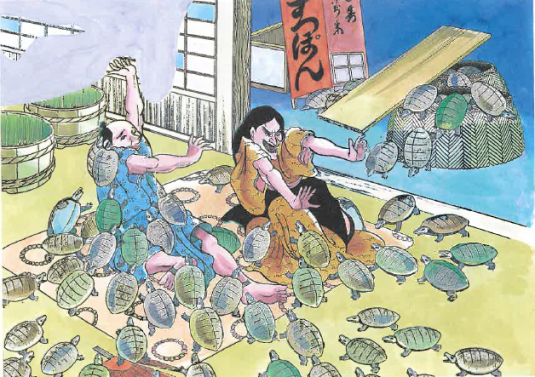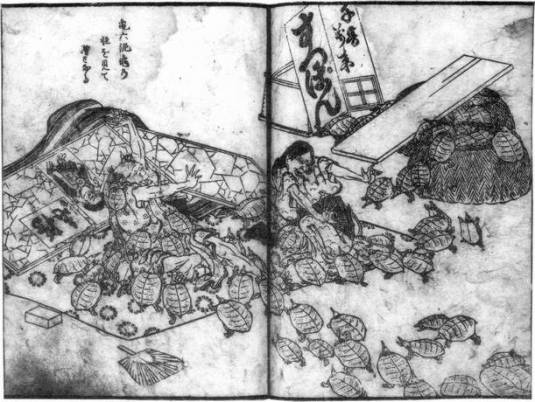
Translated and Sourced from Mizuki Shigeru’s Mujyara, Taihei Hyakumonogatari, Japanese Wikipedia, and Other Sources
This is a tale of the Edo period, from Tajima province (modern day Hyogo prefecture).
A down-on-his luck ronin named Kido Gyobu wandered into Tajima one day. He had heard rumors that there was an obakeyashiki—a haunted house—in town that had lay abandoned and unoccupied for years. Kido was very proud of his courage, and vowed to stay at the house as a Test of Courage.
From outside the house was dilapidated and the garden was overgrown, but it was livable. Kido took his small belongings, which were just his traveling clothes, bedding, and the two swords that it was his right to wear, and went into the house where he would live. He wandered through, kicking up dust and disturbing cobwebs. The tatami-mat floors were old and bug-ridden. The paper in the windows torn and yellow. The cooking utensils rusting. But he found nothing to evoke the terror that was the reputation of the house. Kido put it down to rural superstition, and made a bed for himself in the main room. He spent his day without incident—cooked his food. Took his bath. Drank his sake and smoked his pipe. All which lead him to think that there was nothing to fear.
That night, when Kido had put out the candle and climbed into his futon, the house suddenly lurched and began to shake violently. All of Kido’s belongings were scattered about the room, and the entire house shook like it was in the grips of some monster. Kido assumed it must be a massive earthquake, but when he steadied himself enough to look out the window, he saw the rest of the village was as calm as a pool of still water. It was only inside the house that the world was being shaken to pieces.
With the coming of dawn, the house settled down and the shaking ended. Kido was not to be beaten so easily, and resolved to continue his stay in the house. The second night was identical to the first. The day passed without incident, but at night the house came to live and rattled Kido around like dice in a gambling cup.
Kido had enough of the house, and went to ask advice from a distant relation, a monk named Chisen, who lived in a temple in a nearby village. Chisen listened calmly to his story, and thought for a short while, and told Kido he would accompany him back to the house and stay the night with him.
The third night was a repeat of the first and second—a boring day and a lively night. With the house doing its best to dislodge Kido and Chisen or at least to smash them into something, Chisen sat calmly in the center of the main room as if meditating. He stared intently at the floor for hours as if searching for something, oblivious to the chaos around him. Suddenly, in one swift move Chisen drew Kido’s short sword—which he had tucked into his obi sash—and plunged it into a particular spot in the tatami-mat floor.
The instant Chisen plunged the stabbed into the floor, the house stopped shaking. Blood welled up from the spot Chinsen had stabbed, staining the tatami mats. But that was all. The house was silent. Leaving the sword standing upright in the floor, the exhausted Kido and Chisen settled down for some much needed sleep.
The next morning, they pulled out the knife and lifted up the tatami mat to see what Chisen had wounded. The found an odd memorial plague, reading “Eye-stabbing Sword Bear Memorial Tablet” (刃熊青眼霊位 ). Chisen’s had stabbed the sword directly into the kanji for “eye,” and that was where the blood was welling up from.
Leaving the house, the revealed this to the villagers who told them of an odd legend. Years ago, the man who lived in that house had killed a bear who wandered in from the forest one night. Fearing the wrath of the bear’s spirit, he had a memorial tablet created and a proper funeral given for the bear. But it was apparently in vain, for the bear’s spirit possessed the man and killed him, and had haunted the house ever since. Many strange things were seen in the house every night, and none had dared to stay there until Kido and Chisen.
Translator’s Note:
A definite twist to this Halloween yurei story, eh? I bet you didn’t see that ending coming! I certainly didn’t expect that when I started translating it.
This story originally comes from the Taihei Hyakumonogatari (太平百物語; 100 Stories of Peace and Tranquility). The Taihei Hyakumonogatari uses the title Tajimekuni no Yanari no Densho (但馬国の家鳴の伝承; Legend of the Crying House of Tajime), which Mizuki Shigeru changes to Tajime no Sorei (但馬の騒霊; The Poltergeist of Tajime).
Yanari is a term for a particular type of haunted house that shakes and groans without any visible cause. The kanji translates to家(house) + 鳴(cry), and Harry Potter fans would recognize the Shrieking Shack as a classic Yanari. There are Yanari legends from almost everywhere in Japan. They were popular during the Edo period, with newspapers reporting on local Yanari and particularly popular ones becoming flash tourist attractions as the curious tried desperately to glimpse actual supernatural phenomenon.
Most Edo period portrayals of Yanari show small oni and other yokai on the outside shaking the house. However, these yokai are completely invisible and only their effects can be seen.

Mizuki uses the term sorei, which uses the kanji 騒 (disruptive) +霊 (spirit). This is a rarely used term for poltergeist-style ghosts that rattle the doors and shake walls just like Western poltergeists. Thanks to the movie series, the term sorei has almost disappeared and most people just use the term “poltergeist” (ポルターガイスト) in modern Japanese.
And yes, to the unanswered question–the story ends there. It never goes on to say if Kido and Chisen were successful in banishing the spirit, or if stabbing the memorial tablet did the trick. That part of the story is the most bizarre, as it runs counter to all other Japanese ghost stories. Most ghosts WANT memorials and funerals and to be worshiped. This is the only one I know of where destroying the tablet ends the haunting.
All I can think of is this–that the bear spirit was not Buddhist, and resented the Buddhist memorial tablet and funeral. This makes sense in a way if you think of animal spirits as being more of the Shinto tradition than the Buddhist. And after all, the haunting and hubbub didn’t happen until AFTER the funeral, soooo ….
Further Reading:
For more Japanese ghost and spirit animal stories, check out:
Onikuma – Demon Bear
Kimodameshi – The Test of Courage
The Cursed Mansion of Yoshioka Gondayu
The Long-tongued Old Woman
Yokai of the House













Recent Comments